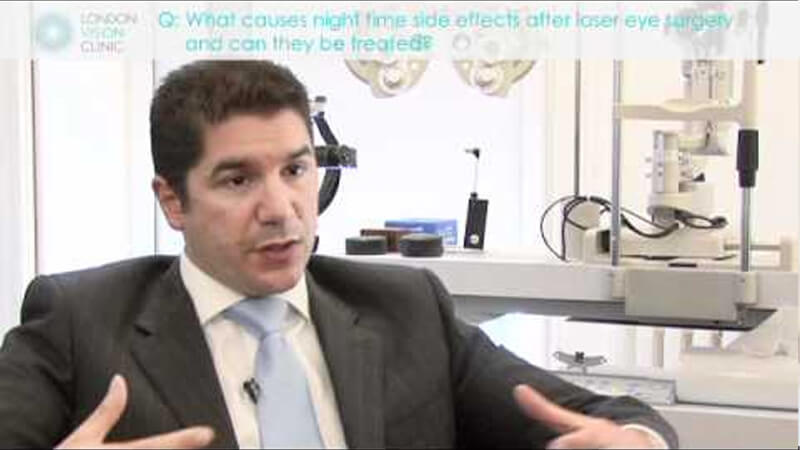What Causes Halos After LASIK?
The appearance of halos is one of the most common side effects associated with Laser Eye surgery treatment. No, that doesn’t mean you will be walking around with a glowing ring floating above your head as soon as you leave the treatment room. We’re talking about another kind of halo.
Visual halos are a form of glare that can temporarily affect vision after undergoing refractive surgery. They occur mainly at night and in low light conditions – for example, as bright circles around light sources such as car headlights and street lamps.
While they are often described as a “side effect” of Laser Eye Surgery, this is not meant in the most common sense of the term (an unintended and often seemingly unrelated consequence of a medication, drug, or surgery).
On the contrary, seeing halos is an expected sign to indicate that your eyes have begun the recovery process. This involves an accumulation of fluid that can cause the eye to swell.
However, as part of the eye’s natural recovery process, every patient who has Laser Eye Surgery can expect to experience glare to some extent – regardless of their age, prescription, or the technique used. Aside from halos, glare can also present itself in the form of starbursts which, rather than being a ring around lights, appear as more of a dispersed glow.
Experiencing halos or other forms of glare generally has a minor impact on a patients life. Some patients may not even notice glare like halos or starburst at all, and those that do simply have to avoid driving for long periods at night.
The real side effects of Laser Eye Surgery

Expert Laser Eye Surgeon, Mr Glenn Carp, explains the effects of night glare after Laser Eye Surgery.
In addition to halos and starbursts, patients may also experience a number of other side effects in the first few weeks after Laser Eye Surgery. For example, some patients may experience minor fluctuations in their quality of vision as it stabilises. Dry eyes (for which clinics provide lubricated eye drops) are also a common occurrence in the days and weeks post-surgery.
However, in the vast majority of cases, each of these side effects is mild and typically resolves within the first few days or weeks.
After around three months, the swelling in the cornea will have settled, along with any visual disturbances. It is not uncommon to continue experiencing a little residual night-time glare after this time. If, however, this is severely affecting your vision, it is recommended that you contact your clinic as further testing may be required. This will allow your surgeon to identify the cause of issue and determine whether a problem needs to be addressed.
While night glare is typically a short-term side effect of Laser Eye Surgery, it is possible for it to persist in the long term. This is most often linked to the presence residual refractive error owing to under- or overcorrection. A small residual prescription or astigmatism can cause halos as well as blurred vision.
Under- or overcorrection can occur for a number of reasons. For example, if every eye was the same and made out of plastic, then every outcome would be 100% accurate; however, that’s not how eyes work. The human eye is a complex biological system that is totally unique from one to the next. As a result, individual healing responses differ from person to person.
Fortunately, the course of action in such cases is relatively straightforward. Many patients who experience glare due to under or overcorrection benefit from having a simple follow-up procedure or even something as simple as wearing glasses at night.
However, halos and night glare can also persist even in cases where the refractive outcomes are perfect. This was particularly a common major side effect of early refractive surgery in the 1990s when the first generation of lasers was still in use.
These were caused by the shape of tissue that was removed by the laser and the area over which the shape change was performedIf the treated area is smaller in size than the pupil (particularly at night when the pupil dilates), the edge of the treatment zone can cause the appearance of halos around light sources.
The Benefits of Evolving Technology
Thankfully, over the last two decades, significant advances in both technology and our understanding of refractive surgery mean that a clinic with the right technology can minimise the risk of halos. For example, surgeons now remove tissue in an a-spheric shape as opposed to a spherical shape, as this better matches the natural state of the cornea. We also now treat an area that is larger than the pupil.
While the risk of night glare and halos is now as low as it has ever been, there is an increased risk for patients with higher prescriptions and/or large pupils. This is just one of the reasons that make a thorough screening process so important. Our screening process allows us to identify any potential risk factors and fully discuss these during the assessment prior to surgery.
But what happens if you do experience long-term night vision symptoms? Well, we now have the technology that can allow us to reduce these, using custom treatment plans that are based on topography scans of the cornea. These scans produce a 3D map of the corneal surface which can be fed into the laser. During treatment, the laser is then able to smooth the surface of the cornea, improving the patient’s quality of vision in the process.
This technology is not currently available at all clinics, so it is worth asking your chosen clinic about their experience with “topography-guided treatments“.
If you would like to learn more about the side effects of Laser Eye Surgery, get in touch with one of our friendly clinic coordinators today. Alternatively, Book a Consultation to find out if you are eligible for treatment.


